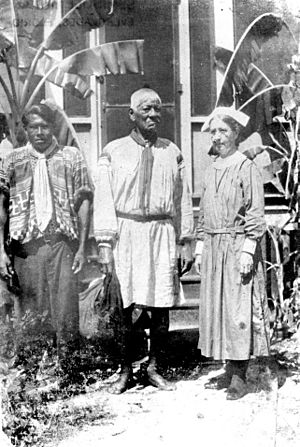Harriet Bedell facts for kids
Quick facts for kids Harriet Bedell |
|
|---|---|

Deaconess Bedell with a medicine man and Bobby Jim Tiger outside the Seminole mission
|
|
| Deaconess and Misisonary | |
| Honored in | Episcopal Church (United States) |
| Feast | 8 January |
Harriet Bedell (born March 19, 1875 – died January 8, 1969) was an important Episcopal deaconess and missionary. She dedicated her life to helping different Native American communities. She worked with the Cheyenne people in Oklahoma, Alaska Natives for 15 years, and the Seminole people in Florida. The Episcopal Church in the United States of America remembers her on its calendar of saints every year on January 8.
Contents
Early Life and Training
Harriet Bedell was born in Buffalo, New York, into a well-known family. She went to public schools and became a schoolteacher. In the early 1900s, she felt a strong calling to become a missionary. She learned about the great need for people to help Native Americans.
In 1906, Harriet began studying at St. Faith's Training School for Deaconesses. Here, she learned many useful skills. These included how to help with nutrition, hygiene, and basic medicine. She also studied theology, which is the study of religious faith.
Her Work as a Missionary
After finishing her training, Harriet Bedell wanted to help people. Her mother preferred she stay closer to home. So, Harriet went to Oklahoma to work as a missionary-teacher with the Cheyenne people.
Helping the Cheyenne People
At the Whirlwind Mission, Harriet worked with David Pendleton Oakerhater, who was a Cheyenne deacon. She helped care for people who were sick or poor. She also led religious services and taught women and children. Harriet spent 10 years helping the Cheyenne. She learned to truly respect their culture. The tribe even adopted her and gave her the name Vicsehia, which means "Bird Woman." Later, she became ill with tuberculosis, a serious lung disease, and had to go to Colorado to get better.
Years in Alaska
In 1916, Harriet Bedell took on a challenging new role in Stevens Village, Alaska. This remote village was about 40 miles (64 km) south of the Arctic Circle. She worked alone there for three years with the Athabascan people.
Harriet also helped start an Episcopal boarding school in nearby Tanana, Alaska. This school was for Native children from rural areas who couldn't easily get to local schools. In 1922, she officially became a deaconess in Portland, Oregon.
By 1931, a tough economic time called the Great Depression made it hard to raise money for the school. Harriet traveled back to New York to help. She managed to raise enough money to pay off the school's debts. However, there wasn't enough to keep the school running, so it had to close.
Serving the Seminole in Florida

During her fundraising trips, Harriet visited a Seminole reservation in South Florida. She felt a strong connection to the people there. In 1932, she decided to move to Florida. She helped bring new life to the Glade Cross mission in Everglades City, Florida. This mission had been started years earlier by Bishop William Crane Gray.
Harriet also started another mission called Our Savior in Collier City. When Collier City closed in 1957, the mission moved to Goodland, Florida. For the next three decades, she worked with different communities in Southwest Florida. This included white settlers, African Americans, and indigenous people.
The native Mikasuki people gave Harriet the name Inkoshopie. This means "woman who prays." They learned to value her advice and her skills in gardening and business. Harriet was upset by local men who wrestled alligators for tourists. She encouraged the women of the tribe to bring back their traditional skills. These included making dolls and weaving baskets. She also encouraged them to use their bright patchwork designs in clothing for everyone.
Harriet helped the Seminole and Mikasuki people sell their crafts to tourists. She worked with the Collier Company and even with department stores in the northern states. She also fought against stores selling imported goods that were falsely labeled as Native American crafts. Selling their artwork at the Glades Cross Mission helped the people earn money. It also helped them feel proud and keep their traditions alive.
In 1947, Harriet Bedell gave a special prayer at the dedication of Everglades National Park. This event was led by President Harry S. Truman. Even though she was officially retired at age 72, she kept working. She made sure the Glades mission would be funded by St. Stephens Episcopal Church. She continued her ministry well into her 80s.
In 1960, Hurricane Donna hit Florida. It destroyed her home and the Glade Cross mission. In Collier County, Florida, the strong winds and floods destroyed many homes.
Later Life and Legacy
After Hurricane Donna, the bishop encouraged the 85-year-old Deaconess Bedell to move to the Bishop Gray Inn in Davenport, Florida. She lived there until she was 94 years old. Even in her later years, she continued to help. She recruited new missionaries, taught Sunday School, and worked in the infirmary for many years. She was buried in Forest Hill Cemetery in Haines City, Florida.
Harriet Bedell was named a "Great Floridian." A special plaque was put up in her honor at the museum in Everglades City. The Episcopal Diocese of Southwest Florida began celebrating her life every year on the anniversary of her death. In 2009, the Episcopal Church (United States) officially added her to its calendar of saints on January 8. Her personal papers and many photographs are kept by the State of Florida and can be viewed online.
Images for kids


